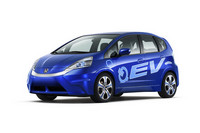2013 Honda Fit EV Rated by the EPA at 118 MPGe; Highest Fuel-Efficiency Rating Ever
 |
The 2013 Honda Fit EV tops all other EV offerings in efficiency ratings, providing the most mileage for your electric dollar
TORRANCE, CA--June 6, 2012: The 2013 Honda Fit EV, with a combined adjusted Environmental Protection Agency (EPA) mile-per-gallon-equivalency rating of 118 MPGe, received the highest fuel-efficiency rating ever given by the EPA. Further, with an unprecedented low consumption rating of just 29 kilowatt hours (kWh) per 100 miles and low EPA rated annual fuel cost of $500, the fun-to-drive 2013 Honda Fit EV can help consumers get more miles for each charging dollar.
With such an efficient drivetrain, the Fit EV's 20-kWh lithium-ion (Li-ion) battery provides the capacity to earn an EPA combined city/highway estimated driving range rating of 82-miles, allowing the Fit EV to surpass the EPA efficiency and range ratings of the Ford Focus Electric (105 MPGe, 76-mile range), Nissan Leaf (99 MPGe, 73-mile range), and Mitsubishi i-MiEV (112 MPGe, 62-mile range). The Fit EV's exceptionally efficient design -- encompassing everything from savvy powertrain design, weight-conscious engineering and effective aerodynamics -- makes the most of the Fit EV's smaller battery. Additionally, the Fit EV battery can be recharged in less than 3 hours from a low charge indicator illumination point when connected to a 240-volt circuit.
"Just as important as the industry-leading fuel-efficiency and fast recharging time, as a Honda, the 2013 Fit EV will be an absolute kick to drive," said Steve Center, vice president of the American Honda Environmental Business Development Office.
The Fit EV's 92 kilowatt (123 horsepower) coaxial electric motor generates 189 ft-lb of torque, and is teamed to a chassis with a fully-independent suspension and a driver-selectable 3-mode electric drive system adapted from the CR-Z Sport Hybrid.
Honda debuted the 2013 Fit EV at the 2011 Los Angeles Auto Show and announced plans to begin leasing the battery-electric commuter vehicle to customers in select California and Oregon markets during the summer of 2012, followed by an East Coast rollout in 2013.
Honda Environmental Leadership
The Fit EV is a part of Honda's portfolio approach, which includes the development of battery- electric, hydrogen, natural gas, and gasoline-electric powered vehicles, to improve fuel-efficiency and reduce C02 emissions. Honda has led the Union of Concerned Scientists (UCS) rankings of overall vehicle environmental performance since 2000, and a Honda vehicle has topped the list of America's greenest vehicles, from the America Council for an Energy-Efficient Economy (ACEEE), for eleven consecutive years.
In 2006, Honda became the first automaker to announce voluntary CO2 emissions reduction targets for its global fleet of automobile, powersports and power equipment products and its global network of manufacturing plants. Today, the company is striving for even greater reductions in CO2 emissions that contribute to global climate change, while also working to minimize waste, water use and the total environmental footprint of its operations worldwide.
|
Honda Fit EV Efficiency Comparison |
||||
|
|
|
|
|
|
|
|
EPA Combined |
EPA Combined |
|
|
|
Model |
MPGe Rating |
kWh/100mi(1) |
Battery Capacity |
EPA Label Range |
|
|
|
|
|
|
|
Honda Fit EV |
118 |
29 |
20 kWh |
82 miles |
|
Mitsubishi i-MiEV |
112 |
30 |
16 kWh |
62 miles |
|
Ford Focus Electric |
105 |
32 |
23 kWh |
76 miles |
|
Nissan Leaf |
99 |
34 |
24 kWh |
73 miles |
|
(1) kWh/100mi (kilowatt hours per 100 miles): A lower number represents superior efficiency |
132/105/118 city/highway/combined miles per gallon of gasoline-equivalent (MPGe) rating; 82 mile combined (city/highway) driving range rating (adjusted). Ratings determined by US EPA. Your MPGe and range will vary depending on driving conditions, how you drive and maintain your vehicle, battery age/condition, and other factors. For additional information about EPA ratings, visit Learn More Electric.


